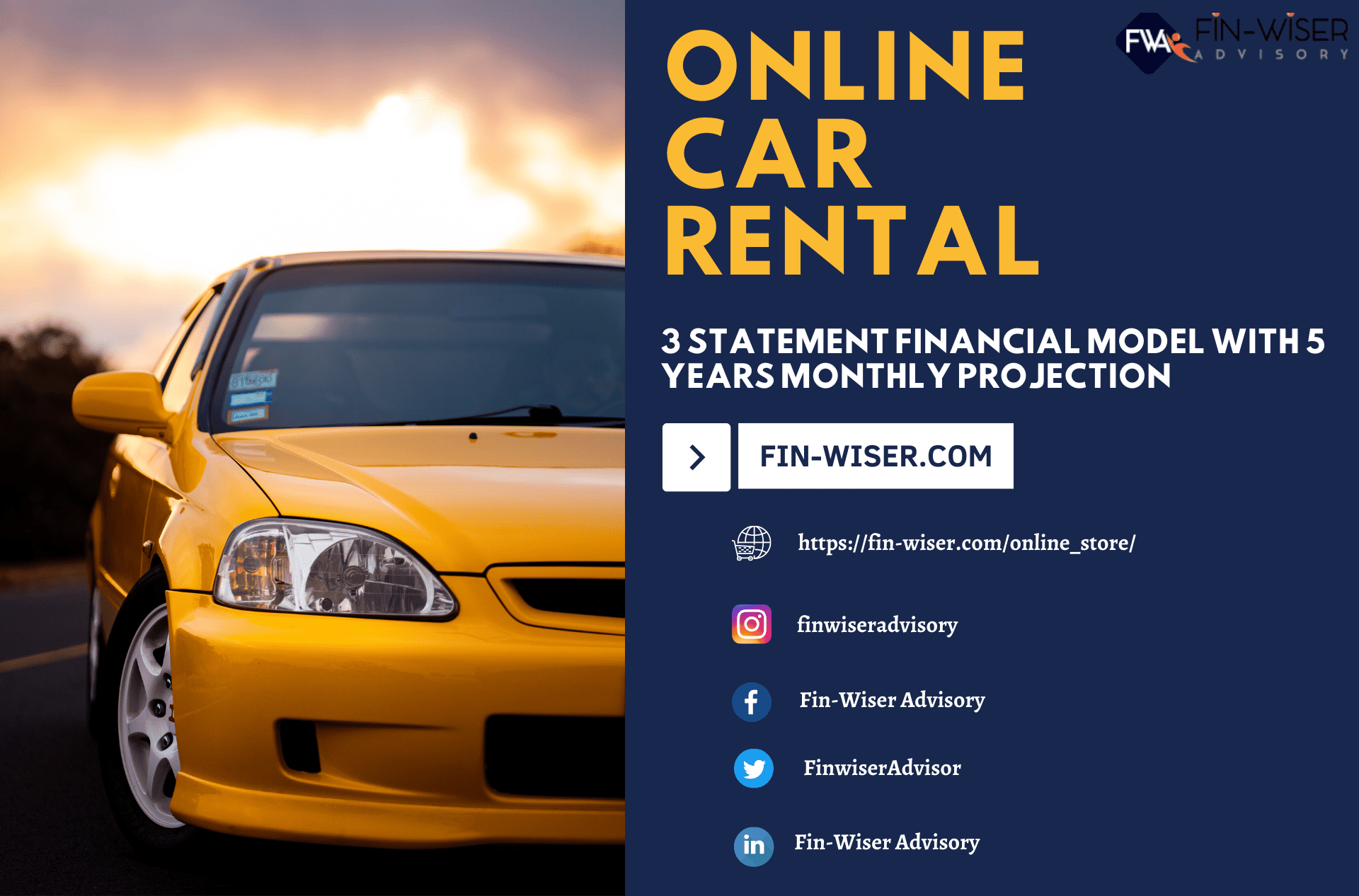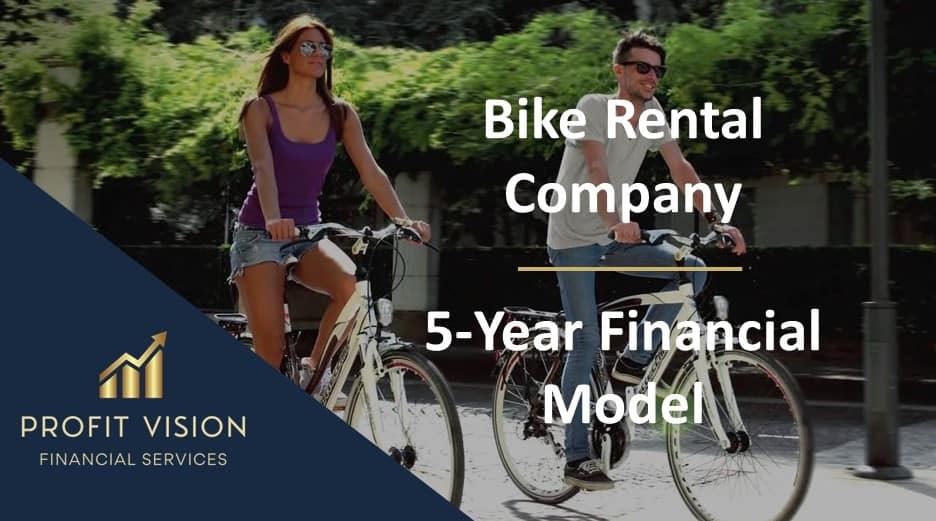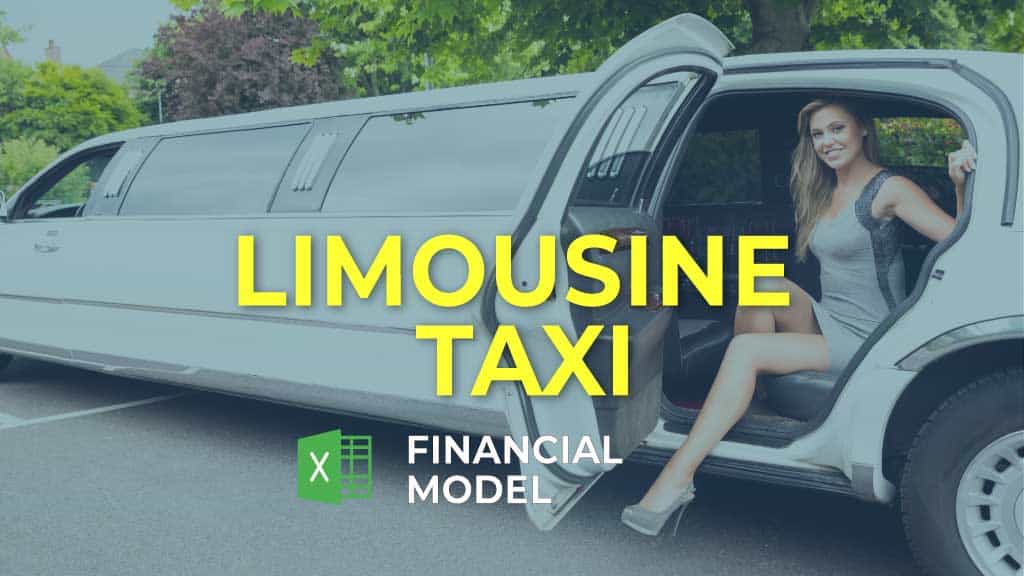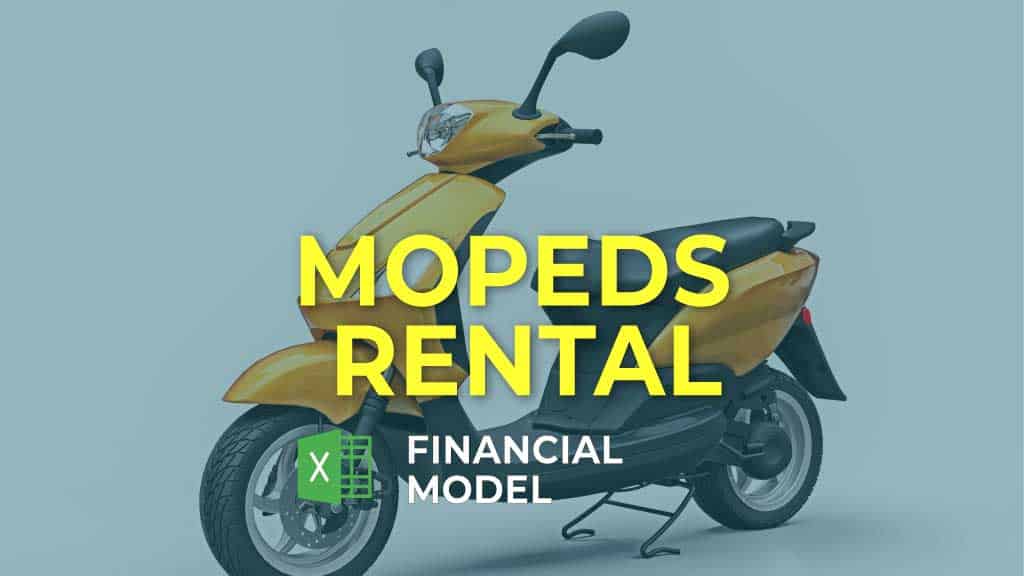Car Rental Business Financial Model
This Car Rental Business Financial Model Template in Excel offers an ideal basis for developing a business plan for a car rental company. The template lays out a bottom-up calculation of the expected revenues and profits of a car rental business model. This includes a comprehensive forecast of the car fleet schedule, the expected occupancy and rental rates, and the expected cost structure from which the revenues and costs can be derived. This results in a comprehensive multi-year financial forecast and a comprehensive financial analysis of a planned car rental business. This analysis can be used for developing a car rental company business plan or as the basis for raising funding from banks or investors and offers a deep understanding of the drivers of the car rental business model.

From budget-friendly sedans to luxury SUVs, demand for car rental remains consistent for tourism, business travel, and local needs. With proper management, a well-located fleet, and effective marketing, a Car Rental Business can generate reliable profits and provide a resilient investment opportunity, especially in popular tourist destinations or urban areas. Starting a car rental business requires significant capital and careful analysis of the financial merits and risks.
Please also refer to the walkthrough video of this financial model template:
Walkthrough Car Rental Business Financial Model Template
Some Key Questions to Answer for a Car Rental Agency Business Plan
When starting a car rental company, there are some key financial questions you want to have answered in your business plan and for which a financial model can provide the basis of your analysis:
- How much is the required investment amount?
- What strategy is better for me, to buy or to lease the rental cars?
- What Prices do I need to charge?
- What will the anticipated costs be when operating this business?
- How many cars can be rented, or at what prices can we break even?
- How long should the cars stay in operation?
- How will Seasonality regarding Rental Occupancy and Prices Affect the Car Rental Business?
- How much cash can this business generate?
- What will the expected monthly and annual profits be?
- How can I expand the car fleet later on, and how much financing will be required?
- How would the debt schedule look like when proposed to the bank for funding?
- What are the projected returns for Equity Shareholders when investing in this business?
Answering questions like these will help make your business plan more solid and avoid many pitfalls, aiming to give your business the best chance to make it profitable.
Understanding the Drivers of Car Rental Business Profit Margin
With this well-developed car rental business financial model, entrepreneurs, business owners, and investors may obtain deep insights into the economics of their car rental business models. Preparing a financial plan allows one to study the financial viability when starting a new car rental business and better prepare for fundraising discussions with banks and investors. The model offers a combination of assumptions and business analysis to truly understand the driving forces of profitability and investor returns for a car rental business:
- The Fleet Size
- The Car Type Mix in the Fleet
- The expected Occupancy Rate of its Car Fleet
- The Pricing Strategy
- Rental Options which allow Upselling
- The average length of Car Rentals
- The Cost Structure
- The Impact of Seasonality on Occupancy Rates and Prices
- The Financing of Cars, either purchasing or leasing
- Use of Bank Financing
All these factors affect the profit margins of car rental businesses, and it is highly recommended that you study how these factors will affect your intended business model. This allows for better planning and enhances your chance of success when starting a Car Rental Agency.
Understanding Car Fleet Expansion and Financing Scenarios
Business profitability and expansion are essential to long-term success in the dynamic world of car rentals. Expanding your car fleet is a strategic move that requires careful consideration, as much capital needs to be invested to expand it. Our car rental financial model spreadsheet template models the expansion of your car fleet and the required replacements when cars reach a certain age to keep your Fleet modern and up to date.
- Model up to 5 expansion steps of your car fleet
- Choose when to lease and when to purchase the cars
- Input the expected car usage period
- Model expected profits/losses from the sale of vehicles once they reach a certain age
- Model the impact of changing the car mix of your fleet over time.
- Take into account new Bank Loans every time you expand your car fleet.
Steer your business toward a prosperous future by carefully planning the expansion of your car rental fleet.
Simulating How Operational Improvements Will Affect Financial Performance
The spreadsheet was designed to help you understand how operational improvements will affect the financial performance of your car rental business over time. This can be especially valuable when trying to figure out the upside potential of your business:
- Occupancy Rates: Experiment with different occupancy rates to gauge their effect on revenue and profitability.
- Rental Prices: Adjust rental prices to balance competitiveness and profitability. Use the seasonality adjustment factor to optimize your income, setting different prices during low and high seasons.
- Adding Rental Options: Selling additional services such as GPS rental and road assistance can increase your revenues. Simulate how the rollout of these services might affect your income.
- Car Usage Duration: Analyze how extending or shortening the average usage duration of rental cars affects your operational performance and cash flows.
- And many more variables to play with.
Obtain a deep understanding of the expected car rental business profit margins.
Features – Car Rental Business Model Spreadsheet Template
The Excel spreadsheet provides a bottom-up approach to planning the financial performance of your car rental business model from the ground up. The calculations result in a financial forecast containing all the relevant metrics typically required by banks and investors. Depending on the model version, a 5-year monthly (Basic Version) or a 10-year monthly (Premium Version) forecast period is included.
Spreadsheet Structure
The worksheets inside this spreadsheet are structured as follows:
- Instructions and Terms of Abbreviations: We included a short briefing on the key concepts used in this template, terms and abbreviations, and how to work with it.
- Assumptions Sheet: A worksheet to enter the assumptions of your financial plan.
- Financial Calculations: A Comprehensive Monthly Forecast (5 or 10 Years) is then aggregated into an Annual Sheet.
- Budget Analysis: Zoom in on any select year to better understand the Monthly Forecast and Budget
- Detailed Summary: Contains tables and charts that illustrate the result of the projected financial plan and allow for deep analysis.
Main Features
The spreadsheet comes with the following main features:
- Car Fleet Schedule: The model includes a detailed car fleet schedule, modeling the additions, disposals, and replacements of up to 6 different car types in your fleet. This is coupled together with the expected usage time per car type and the timing of the planned expansion steps.
- Car Fleet Ownership: The model foresees that the cars either (1) will be purchased (CAPEX), activated on the Balance Sheet, and depreciated, or (2) will be leased (leading to monthly costs included in OPEX).
- Car Resales at the End of the Planned Utilization: The model assumes that the purchased cars are only utilized during the specified period and are sold afterward. The sale of the old cars results in Gains/Losses from old Car Disposals. These gains/losses are calculated depending on the difference between the assumed resale price and the approximate book value at the time of sale.
- Revenue Model: The model foresees revenues from the rental of cars, rental income of additional options such as renting GPS or selling assistance services, gain from the disposal of cars, and other income that can be freely set.
- Car Rental income is estimated by the number of cars in operation, the average daily rental rate, and the expected occupancy rate of the car fleet. Both occupancy rate and average daily rental prices can be adjusted monthly to reflect the business’s seasonality.
- Land and Building: The model foresees that you can own/rent a property, which is also valued separately at exit, to maximize the value of your business.
- Cost Assumptions and Schedules are available for Capital Expenditures (CAPEX), employee costs, and Operating Expenses (OPEX).
- Detailed Monthly and Yearly Financial Statement Projections: The spreadsheet is designed logically, outlining the calculations of revenues and costs, which adds to the transparency and understanding of the model. This then results in forecasted financial statement projections—income Statement, Balance Sheet, Cash Flow Statement, and Financial Ratios—together with a series of tables and breakdowns to understand the drivers and composition of profitability.
- Forecasted Business Valuation: The valuation is broken down into Business and Property values. This approach enables investors to optimize their exit value through potential sale and leaseback scenarios at exit.
- Free Cash Flow Projections: Unlevered and levered cash flow projections are provided. The differentiation in levered/unlevered allows us to understand how much the use of debt financing is affecting the expected project and investor returns.
- Funding Amount, Uses and Sources of Funds and Financial Metrics: The model calculates the required financing amount to execute your business plan, provides a suggested breakdown of uses and sources of funds and the resulting financial metrics of your business plan: Internal Rate of Return, Cash on Cash Yield, Payback Period, Net Present Value (NPV).
- Summaries, Charts, Schedules: The financial plan is summarized in a condensed Executive Summary, a Detailed Summary containing more breakdowns, charts, and tables, and a Budget Analysis sheet, which focuses on understanding the budget for a select forecast year.
Overall, this spreadsheet tool was designed to obtain a solid understanding of how the assumptions will impact the economic performance of the business and allow for modeling countless financial scenarios. Improve your financial decision-making today by using this car rental spreadsheet template.
| PREMIUM VERSION | BASIC VERSION | |
| Forecast Period | 10-Years Monthly | 5-Years Monthly |
| Car Types | YES | YES |
| Car Replacement | YES | YES |
| Seasonality Adjustments | YES | YES |
| Expansion Steps | YES | YES |
| Lang and Building: Own/Rent | YES | YES |
| Three Statement Forecast | YES | YES |
| Detailed Financial Summary | YES | YES |
| Executive Summary | YES | YES |
| Debt Schedule | YES | YES |
| Break-Even Analysis | YES | NO |
| Investor Cash Flows and Returns | YES | NO |
| Sensitivity Analysis | YES | NO |
Start Your Car Rental Company with this Financial Model Template
This financial model template comes pre-filled with an example forecast of a Car Rental Company business to illustrate clearly how the spreadsheet works. The forecast can be easily changed by altering the assumptions in blue and light blue font color.
The fully editable Excel model is available in two versions, Basic and Premium. The current model version is 2.3. PDF Demo versions are available for Free Download to understand the Model Structure. The table below offers a comparison between the Basic and Premium Version.
File Types:
.xlsx (MS Excel)
.pdf (Adobe Acrobat Reader)
Similar Products
Other customers were also interested in...
Online Car Rental – 3 Statement Financial Mo...
Online Car Rental Platform Business Plan Model is a perfect tool for a feasibility study on launchin... Read more
Car Rental Financial Model Excel Template
Order Car Rental Pro-forma Template. Simple-to-use yet very sophisticated planning tool. Get reliabl... Read more
Crane Rental Company Financial Model
Dive into the financial planning of your Crane Rental Company with our comprehensive 10-year monthly... Read more
Bike Rental Company – 5 Year Financial Model
Financial Model providing an advanced 5-year financial plan for a startup or operating Bike Rental C... Read more
Car Rental Company Financial Model – Dynamic 10 ...
A Financial model presenting a business scenario of a Car Rental Company which offers Daily Car Rent... Read more
Freight Brokerage Financial Model Excel Template
Discover Freight Brokerage Pro Forma Projection. Impress bankers and investors with a proven, strate... Read more
Limousine Taxi Financial Model Excel Template
Order Limousine Taxi Pro Forma Projection. Impress bankers and investors with a proven, strategic bu... Read more
Mopeds Rental Financial Model Excel Template
Impress bankers and investors with a proven, solid Mopeds Rental Pro Forma Projection. Five-year mop... Read more
Concierge Service Financial Model Excel Template
Impress bankers and investors with a proven, solid Concierge Service Pro Forma Projection. Highly ve... Read more
Private Aircraft Rental Company Financial Model
Embark on a journey to financial mastery with our Private Aircraft Rental Company Financial Model, w... Read more
You must log in to submit a review.



























